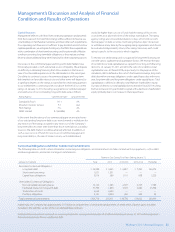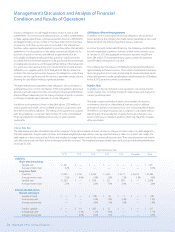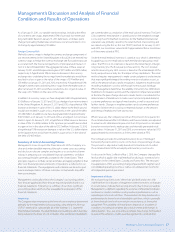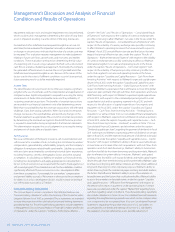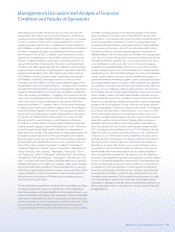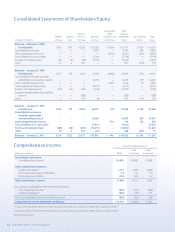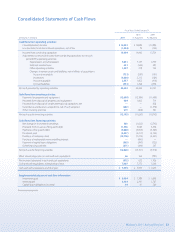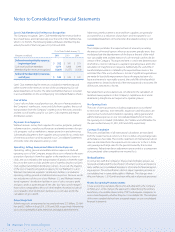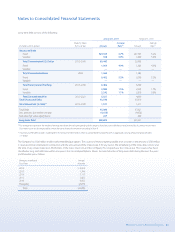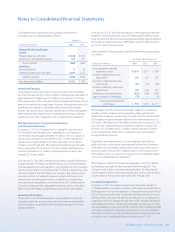Walmart 2011 Annual Report Download - page 37
Download and view the complete annual report
Please find page 37 of the 2011 Walmart annual report below. You can navigate through the pages in the report by either clicking on the pages listed below, or by using the keyword search tool below to find specific information within the annual report.
Walmart 2011 Annual Report 35
Capitalized Interest
The interest costs associated with construction projects are capitalized
and included as part of the cost of the project. When no debt is incurred
specically for a project, interest is capitalized on amounts expended on
the project using our weighted-average cost of borrowing. Capitalization
of interest ceases when the project is substantially complete. Interest
costs capitalized on construction projects were $63 million, $85 million
and $88 million in scal 2011, 2010 and 2009, respectively.
Long-Lived Assets
Long-lived assets are stated at cost. Management reviews long-lived
assets for indicators of impairment whenever events or changes in circum-
stances indicate that the carrying amount may not be recoverable. The
evaluation is performed at the lowest level of identiable cash ows,
which is at the individual store level or in certain circumstances a market
group of stores. Undiscounted cash ows expected to be generated by the
related assets are estimated over the asset’s useful life based on updated
projections. If the evaluation indicates that the carrying amount of the
asset may not be recoverable, any potential impairment is measured based
upon the fair value of the related asset or asset group as determined by
an appropriate market appraisal or other valuation technique.
Goodwill and Other Acquired Intangible Assets
Goodwill represents the excess of the purchase price over the fair value
of net assets acquired in business combinations and is allocated to the
appropriate segment when acquired. Other acquired intangible assets
are stated at the fair value acquired as determined by a valuation tech-
nique commensurate with the intended use of the related asset. Goodwill
and indenite-lived intangible assets are not amortized; rather, they are
evaluated for impairment annually during our fourth scal quarter or
whenever events or changes in circumstances indicate that the value of
the asset may be impaired. Denite-lived intangible assets are considered
long-lived assets and are amortized on a straight-line basis over the periods
that expected economic benets will be provided.
Goodwill is evaluated for impairment by determining the fair value of the
related reporting unit. Fair value is measured based on the discounted
cash ow method and relative market-based approaches. The analyses
require signicant management judgment to evaluate the capacity of an
acquired business to perform within projections. The Company has not
recorded impairment charges related to goodwill.
The following table reects goodwill activity, by operating segment,
for scal years 2011 and 2010:
Walmart
(Amounts in millions) Walmart U.S. International Sam’s Club Total
February 1, 2009 $207 $14,740 $313 $15,260
Currency translation
and other — 866 — 866
January 31, 2010 207 15,606 313 16,126
Currency translation
and other — 605 — 605
Acquisitions 32 — — 32
January 31, 2011 $239 $16,211 $313 $16,763
During scal 2011, Walmart U.S. completed an immaterial business
acquisition that resulted in the recognition of $32 million in goodwill.
Indenite-lived intangible assets are included in other assets and
deferred charges on the accompanying Consolidated Balance Sheets.
These assets are evaluated for impairment based on their fair values
using valuation techniques which are updated annually based on the
most recent variables and assumptions. There were no impairment
charges related to indenite-lived intangible assets recorded during the
scal years ended January 31, 2011, 2010 and 2009.
Self-Insurance Reserves
The Company uses a combination of insurance, self-insured retention
and self-insurance for a number of risks, including, but not limited to,
workers’ compensation, general liability, vehicle liability, property and
the Company’s obligation for employee-related health care benets.
Liabilities relating to these claims associated with these risks are esti-
mated by considering historical claims experience, including frequency,
severity, demographic factors, and other actuarial assumptions. In esti-
mating our liability for such claims, we periodically analyze our historical
trends, including loss development, and apply appropriate loss develop-
ment factors to the incurred costs associated with the claims. See Note 6.
Income Taxes
Income taxes are accounted for under the liability method. Deferred
tax assets and liabilities are recognized for the estimated future tax con-
sequences attributable to dierences between the nancial statement
carrying amounts of existing assets and liabilities and their respective
tax bases. Deferred tax assets and liabilities are measured using enacted
tax rates in eect for the year in which those temporary dierences are
expected to be recovered or settled. The eect on deferred tax assets
and liabilities of a change in tax rate is recognized in income in the period
that includes the enactment date. Valuation allowances are established
when necessary to reduce deferred tax assets to the amounts more likely
than not to be realized.
The Company records a liability for unrecognized tax benets resulting
from uncertain tax positions taken or expected to be taken in a tax return.
The Company records interest and penalties related to unrecognized
tax benets in interest expense and operating, selling, general and
administrative expenses, respectively, in the Company’s Consolidated
Statements of Income.
Revenue Recognition
The Company recognizes sales revenue net of sales taxes and estimated
sales returns at the time it sells merchandise to the customer. Customer
purchases of shopping cards are not recognized as revenue until the card
is redeemed and the customer purchases merchandise by using the
shopping card. The Company also recognizes revenue from service
transactions at the time the service is performed. Generally, revenue from
services is classied as a component of net sales on our Consolidated
Statements of Income.
Notes to Consolidated Financial Statements


